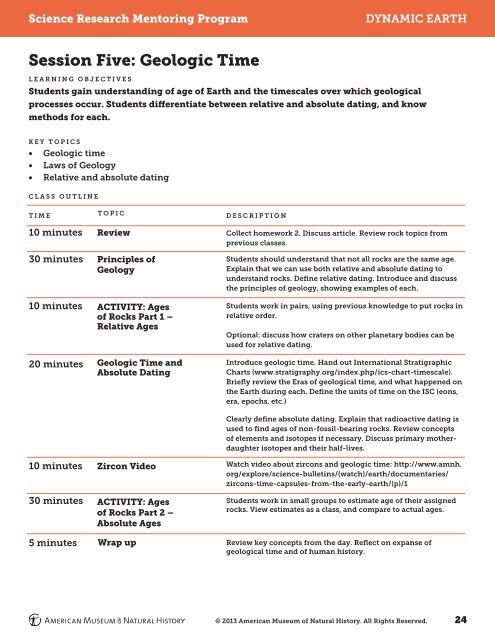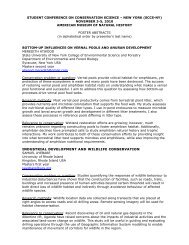SRMP Dynamic Earth Curriculum - American Museum of Natural ...
SRMP Dynamic Earth Curriculum - American Museum of Natural ...
SRMP Dynamic Earth Curriculum - American Museum of Natural ...
Create successful ePaper yourself
Turn your PDF publications into a flip-book with our unique Google optimized e-Paper software.
Science Research Mentoring Program<strong>Dynamic</strong> <strong>Earth</strong>Session Five: Geologic Timelearning objectivesStudents gain understanding <strong>of</strong> age <strong>of</strong> <strong>Earth</strong> and the timescales over which geologicalprocesses occur. Students differentiate between relative and absolute dating, and knowmethods for each.key topics• Geologic time• Laws <strong>of</strong> Geology• Relative and absolute datingClass outlinetime10 minutes30 minutes10 minutes20 minutes10 minutes30 minutes5 minutesTOPICReviewPrinciples <strong>of</strong>GeologyACTIVITY: Ages<strong>of</strong> Rocks Part 1 –Relative AgesGeologic Time andAbsolute DatingZircon VideoACTIVITY: Ages<strong>of</strong> Rocks Part 2 –Absolute AgesWrap updescriptionCollect homework 2. Discuss article. Review rock topics fromprevious classes.Students should understand that not all rocks are the same age.Explain that we can use both relative and absolute dating tounderstand rocks. Define relative dating. Introduce and discussthe principles <strong>of</strong> geology, showing examples <strong>of</strong> each.Students work in pairs, using previous knowledge to put rocks inrelative order.Optional: discuss how craters on other planetary bodies can beused for relative dating.Introduce geologic time. Hand out International StratigraphicCharts (www.stratigraphy.org/index.php/ics-chart-timescale).Briefly review the Eras <strong>of</strong> geological time, and what happened onthe <strong>Earth</strong> during each. Define the units <strong>of</strong> time on the ISC (eons,era, epochs, etc.)Clearly define absolute dating. Explain that radioactive dating isused to find ages <strong>of</strong> non-fossil-bearing rocks. Review concepts<strong>of</strong> elements and isotopes if necessary. Discuss primary motherdaughterisotopes and their half-lives.Watch video about zircons and geologic time: http://www.amnh.org/explore/science-bulletins/(watch)/earth/documentaries/zircons-time-capsules-from-the-early-earth/(p)/1Students work in small groups to estimate age <strong>of</strong> their assignedrocks. View estimates as a class, and compare to actual ages.Review key concepts from the day. Reflect on expanse <strong>of</strong>geological time and <strong>of</strong> human history.© 2013 <strong>American</strong> <strong>Museum</strong> <strong>of</strong> <strong>Natural</strong> History. All Rights Reserved. 24
















